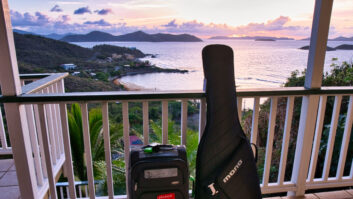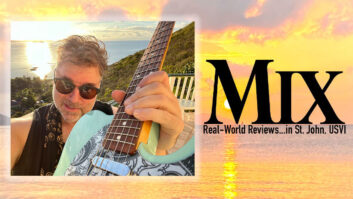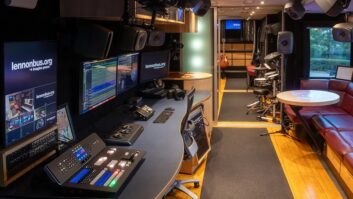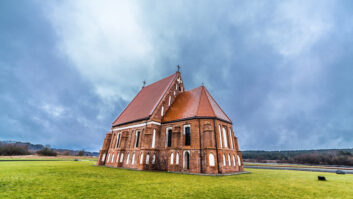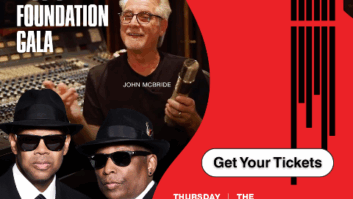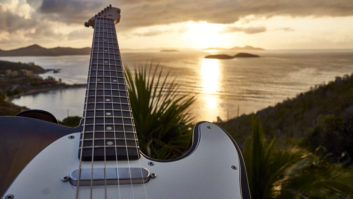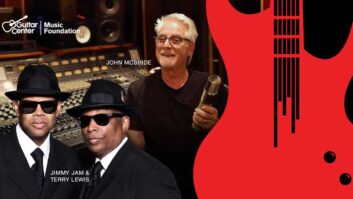For the past three years, Rich Tozzoli has organized a grand recording, gigging and equipment review opportunity by gathering his most fun-loving musician and audio-engineering friends, a select batch of gear and heading to the Caribbean. For 2015, Rich returned to paradise with some of the best performing, travel-friendly recording equipment yet.
This year’s music adventure down to St. John USVI—where good friends and I record, mix, compose and do a few live shows each year—was a blast once again. It started upon arrival with a massive downpour and a nice long wait for our luggage. By the time it rolled off the belt, it was clear that they had left it out in the rain for a while. After drying the luggage off and confirming the gear we had with us was safe, the sun broke through and it was blue skies and island breezes for the next two weeks.
It was basically the same production crew as last year: Clubhouse Studio owner Paul Antonell and engineer Mike Dwyer and myself. Drummer/percussionist Ray Levier and bassist Hank Skalka, who owns the house in St John, were joined for the first week by talented keyboardist/synthesist Bruce MacPherson, who, in addition to having a long history in the pro audio business, has played with the likes of Fleetwood Mac and programmed for groups such as Yes. Vocalist/guitarist Scott E. Moore would join us the second week for some studio work and to play our live shows. It doesn’t hurt that Moore is also a high-level chef; we all know great food music (and bourbon) pair perfectly together, especially a few thousand miles from home.
Upon arrival to the house, we were joking that it was like Christmas. A healthy but streamlined stack of boxes awaited us, filled with cool audio toys. In them, we had a pair of Millennia HV-35P mobile preamplifiers, a pair of AEA N8 ribbon microphones for the recording sessions, four channels of Teegarden Audio Fatboy Gear Tube DI, a pair of Elite Acoustics Designs’ Sunburst Gear M3BR8 multipurpose powered monitors, a Shure KSM9HS handheld vocal microphone and an Audio-Technica AE-2500 dual-element kick drum microphone for both studio and live gigs. MacPherson had a keyboard stand and a 61-key controller shipped down, and I carried down an Eventide H9 harmonizer multi-effects pedal, iPad and Novation Bass Station II synth—the latter of which, from being a true analog synth, acted as my MIDI controller.
After a few years of doing this retreat, I have come to realize how keeping everything compact and small pays off. Both Antonell, who set up Studio A in the main house, and I, who had Studio B in the cottage, each ran a MacBook Pro with Universal Audio Apollo Duo interface. Each of us also had UAD Satellite DSP accelerators for full power mode. We set the cool little Sunburst M3BR8 speakers up for the main studio and, at my rig, my NHT Pro M-00s with S-00 sub monitoring rig, which was still packed away in the house from last year. With minimal setup and most everything running on Thunderbolt or USB 3.0, we were up and running in no time at all. In fact, I had a tight deadline on a show back home, so the first night there, MacPherson and I quickly cut tracks for A&E, which I promptly uploaded to the client’s FTP server.
For drives, both studios used Glyph Studio Mini 1 TB models. These silent little powerhouses are great, because not only do they eschew fans, but they feature USB 3.0, dual FireWire 800 ports and eSATA connectivity. They are bus-powered via USB or FW, have a rear power switch and the ability to run via optional AC adapter, if needed. In St. John, I would record parts in Studio B, then just bring the drive up and hook it up to Studio A. Since we both ran the exact same setup—Pro Tools 11 with Universal Audio UAD v8.0 and UAD Console 2.0— interchange was seamless.
Like last year, the main living room of Skalka’s house was transformed into a recording and rehearsal space. A snake ran from the live room into Studio A (Antonell’s bedroom) and, using his Apollo Duo, he and Dwyer were able to send a headphone feed to a four-channel headphone preamp, allowing each of us to have individual volume control.
On Levier’s kit—placed in the corner with walls blanketed—we used the AEA N8 ribbon mic pair as overheads; they feature the same aluminum ribbon as the R44 model. The N8 features a classic bi-directional figure-8 pattern, and it’s a phantom-powered ribbon; it was great to capture the high ceiling sound of the drums. The N8 pair ran through a pair of Millennia HV-35P preamps, which are extremely clean and clear. It feels a bit unusual to engage +48 VDC phantom knowing there is a ribbon mic on the other end of the line, but that’s part of what makes these things sound so good.
For some of the TV tracks we were doing— minimally-miked, classic old-school reggae— I knew I would be compressing the N8 overheads pretty hard, using the Universal Audio 1176 REV E. Luckily, the N8s handle compression extremely well, and their soft but true sound didn’t get harsh when I hit them. The room from the upward facing pattern of the N8s really came alive with the high ceilings and sharp crisp tone, and the direct sound was nice and beefy. “I gotta have these!” was my response when hearing them for the first time. During week two, we also used an N8 on Moore’s acoustic guitar; again, they were extremely smooth and pleasing.
Back to the drums: On the kick, we used the Audio-Technica AE2500 dual element cardioid mic—basically two mics in one. It features a cardioid condenser and a dynamic capsule in one housing, broken out into two XLR cables. Antonell and Dwyer placed it on the front beater side of the kick, and we were all pleased to hear two distinct sounds from this one mic: the first, more of a low thump or thud; the other, more tick or top. As a bonus, we also used the AE2500 live at the gigs and all I can say is, “wow”—I distinctly remember hearing that kick for the first time as it shook the stage.
The Shure KSM9HS also served double duty, acting as the main vocal mic for Moore at the gigs and as an additional acoustic guitar mic in studio. We all agreed it is superb— with crisp, punchy highs and a low, low feedback point in live settings. It has two polar patterns: hyper- cardioid and sub-cardioid—just unscrew the pop screen to access the switch. We found “hyper” to be best for gigs and “sub” best in the studio, for obvious reasons.
The Fatboy tube DIs got quite a workout, as we used them in the live room with a stereo direct output of my Eventide H9 and a single channel down in Studio B for my guitar DI into the Apollo Duo. None of us had heard these before, so we were all ears. The thing that pleased me the most—and what I noticed immediately— was how turning up the Beef knob made the DI even spongier; to a guitar player’s touch, this is gold. I was so impressed when first plugging it in that I had the guys come down to make sure I was hearing what I was hearing. Once I went beyond the 12 o’clock position of the Beef knob, you can hear the tube start to break up in a soft, pleasing, non-obtrusive way: “I gotta have one of these too!” I thought. My credit card will take a beating after this trip, but hey, I like the good stuff. What can I do?
Back up in Studio A, MacPherson’s keyboard rig—fed into a small mixer—ran stereo into a two-channel racked Fatboy DI. We also brought that DI out to the live show; MacPherson ran his laptop keyboard rig through it and into the console. The Fatboy DIs were also on Levier’s Wavedrum and Skalka’s six-string bass—both especially cool for the old-school reggae cuts.
One of the biggest gear surprises of the trip was how much we all liked the Sunburst Gear M3BR8 powered speakers, which have a 5 ¼-inch woofer and one-inch tweeter. They are heavier than they look (in a good way). We used them first as playback monitors with Anontell’s audio rig. Being also rechargeable battery powered Bluetooth-ready PA speakers (with pole mounts on the cabinets’ bottoms), we took them to the gigs, too—one as a monitor for Moore’s vocal, the other as a monitor for MacPherson’s keyboard rig. Our main speakers were QSC Audio. Of course, we had to keep the M3BR8s at reasonable levels or they would break up; they are not large, but small “personal” monitors. For our purposes, they were great. At night, we would play music through them, all battery powered, and relax on the deck, so they got quite a workout throughout the entire retreat.
Another useful gear surprise was the ability to link together two Apollo interfaces using Universal Audio’s new V2 Console software. This let us create a compact four-channel rig, where one of the Duo’s acted as a master with main output volume control. We used that in both studio setups as needed; it’s great to be able to link multiple Apollo units together to create a bigger system.
Down in Studio B, I did a lot of composing for a variety of TV shows; some of it was keyboard-based, others parts guitar-based. For the guitar tracks, I ran into the Fatboy DI, then directly into Apollo. In UA’s console software window, I ran a variety of amps and effects direct. One of my favorite paths was the Friedman DS40 into Ocean Way Studio for room sound and an RE-201 for delay and reverb. Sadly, I had forgotten how cool it is to “commit,” as we call it, and simply print the guitar sound.
Sometimes, I would plug the Fatboy’s Thru output into my Eventide H9. In turn, the H9 fed the Apollo and I used my iPad for full Bluetooth control of the pedal. The H9 truly is a film score in a box, and I even did some cues one evening running the Novation Bass Station II into it, putting on a cool ambient preset and tweaking the filters on the synth. Looking out the window at the sun setting on the waves, it was one of those striking “mind picture” moments on the retreat for me.
The Novation Bass Station II was another treat to have on this trip, and I used it as a MIDI controller with full size keys (two octave) and, of course, as an analog mono synth. MacPherson came in and gave me a good synthesis lesson [See his adjacent sidebar—Ed.] and then we did some great TV cue work with it.
There are lessons I have learned doing remote mobile recordings. First and foremost, I can never have enough hard drives or oddball cables—“ ding-alongs,” we call them— now including Thunderbolt, optical, 1/8-inch mini, USB and headphone adapters. Secondly, actively working alongside my peers is immeasurably valuable. It is great to learn from others in person, where we can share our audio knowledge on the spot, then unwind on the deck and look up into the sky each night with my good colleagues that are also good friends. Oh yeah, and I can’t forget about that good bourbon.
Rich Tozzoli is a producer, mixer, engineer and musician/composer for programming such as A&E’s Duck Dynasty, History Channel’s Pawn Stars, Harpo Studios’ 21-Day Meditation Challenge and more.
Novation Notes by Bruce MacPherson
About a half-hour to read the manual and get familiar with this little synth was all the time I had available before putting it in to use for a few TV cues and later, an evening gig. Its two DCOs (digitally controlled oscillators) had a nice way of acting a little like VCOs (voltage controlled oscillators) without the warm up time needed to be in tune. Its very slight detuning had a nice phasing type of character that I love and usually don’t hear in the DCOs of modern synths. The filter was smooth and the additional “Acid” setting was great for a more “rude” sound. Quick, punchy envelopes also delivered above my expectations.
Calling it a Bass Station seems to limit how one may use it; it’s a very capable lead synth as well as great for sound effects. A logical path and great layout made it fun to work the synth while playing it live as well as in the studio. At one point, Rich was working the Filter Cutoff while I was playing the keyboard, using the Pitch and Modulation wheels—fun for the whole family. The Arpeggiator and Sequencer both synced up with our DAW’s MIDI beat clock by simply sending it to the Bass Station II; this was a surprise since most synths usually need to be told to look for it.
Personally, two octaves aren’t enough for me, but hooking up a longer keyboard is simple with MIDI I/O and USB connection. The Bass Station II has a great sound and deep flexibility for a synth its size.
